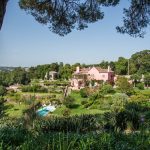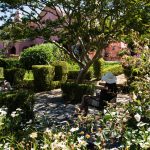The Sacred Spaces of Sintra….and Mons Lunae
Some places have a special, and what some might call, sacred, feel about them. Sintra certainly falls into this category. If you are going to get away for a retreat to somewhere special, then Sintra certainly ticks a lot of boxes.
It is often worth understanding and appreciating a bit of the history and culture of a location to enhance our current experience of space and place.
Whether it is due to its physical and geographic conditions, or its coastal mountain position where sea mists commonly swirl around forested hill tops, a mythology of Sintra has been developed over the centuries.
An association between Sintra and the Moon has attracted a board range of Romantic literary figures whose prose and poetry have further enhanced Sintra’s reputation.
The ancient Greek and Roman classical writers talked of Sintra as ‘Mons Lunae’, the sacred Mount of the moon, where the ancient practices of moon worship were performed since time immemorial.
The ancients of Sintra worshipped Cynthia, whose name was derived from Cynthos, a mountain on the sacred island of Delos, the birthplace of the gods. This was the Greek Artemis or Roman Diana, goddess of the moon and of hunting, sister of Apollo, and god of light. From the word Cynthia came finally Cintra, and the name today of Sintra.
As Malcolm Jack points out in his book- Sintra, A Glorious Eden, the lunar observations of the early Iberians were matched by an interest in solar eclipses. Sun and moon formed a duality- ‘Apollo, god of the sun, balanced the luminous, feminine Artemis, his sister, with a masculine energy and virility. From the sun came warmth upon which life depended, while the moon was thought to impart a serenity that turned man into a cultural being, concerned with interpreting his existence and with creating images’.
The physical sense of sacredness and otherness made Sintra a good place to locate monasteries where monks could be close to nature.
During the Spanish Interregnum (1580 -1640) where Portugal fell under Spanish control, King Felipe II of Spain boasted that the sun never set on the lands he governed and then went on to say that his kingdoms contained the richest and poorest convents in the world: the Escorial in Spain was the richest and the Capuchin (Capuchos) in Sintra was the poorest.
The Convento dos Capuchos is a tiny troglodyte hermitage, buttressed by huge boulders and darkened by surrounding trees. The monastery was built in 1560 to house twelve monks. Some of the cells were little more than hollows in the rock and were lined with cork. One recluse, Honorius, spent 36 years here. He was 95 when he died so the cold and rocky surroundings were obviously not unhealthy despite their small size.
At the beginning of the 19th Century, an English writer Hobhouse visited the Cork convent, where there were seventeen monks, ‘from the strictest Franciscan order who take neither meat nor wine,’. He was shown the underground cell in which the monk Honorarius spent thirty years, of whom Byron comments in Childe Harold, Canto I, verse 22: ‘Deep in yon cave Honorius long did dwell / In hope to merit Heaven by making earth a Hell’.
Today, there is also a recently built Tibetan Buddhist monastery in Sintra reflecting the growth of Western Buddhism across Europe. The moon has a special place in Buddhism so it is maybe appropriate that this monastery should be located on Mons Lunae. Similar to astrological and scientific perspectives, Buddhists believe that the moon has a strong effect on the human body.
Traditionally it is taught that on a full moon we should take more time to relax. To celebrate the moon like a Buddhist, all we need to do is sit back for a moment and become a little more still!





